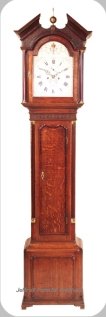|




Stock No. C834
Price: SOLD
|
An attractive longcase clock by
John Smith, Coventry
c1785
- The oak case has mahogany crossbanding and mahogany pillars with brass capitals.
It has an architectural pediment with blind fret and a central finial (replaced).
- The freestanding hood pillars and the trunk quarter pillars are of mahogany. The hood and trunk doors have mahogany crossbanding to the perimeter, as does the applied panel to the base. The clock has an attractive blind fret below the dial, with a similar fret on the pediment.
- The clock stands on small ogee shaped feet and is 7' 8½" high including the finial.
- The clock has a subsidiary seconds dial, a date aperture and strikes the hours on a bell. The 4-pillar movement has an anchor escapement and rack striking.
- The painted dial of this clock is 12 inches wide and is signed Jn.o Smith Coventry. It was painted by Wilson of Birmingham; the false plate is stamped Wilson and the rear of the calendar disc stamped Wilson Birm.
The dial was made by James Wilson of Birmingham, a noted early dial maker.
The paint work is original and if you look closely, some slight crazing of the white background can be seen - proof that this is the original surface.
The blued steel hands are original.
- The clock has a subsidiary seconds dial, a date aperture and strikes the hours on a bell. The 4-pillar movement has an anchor escapement and rack striking.
John Smith is recorded as working in Coventry when he took Charles Evans as an apprentice on 29 September 1785. He was still in business in Coventry in 1795. James Wilson, one of the first painted dial makers, was working in Birmingham from 1777 until his death in 1809.
|

